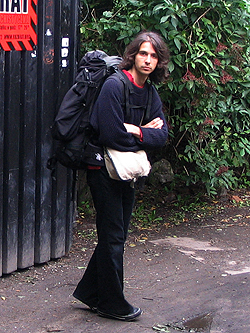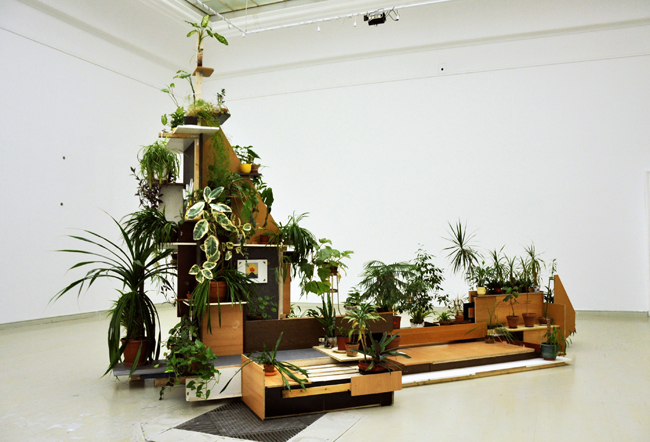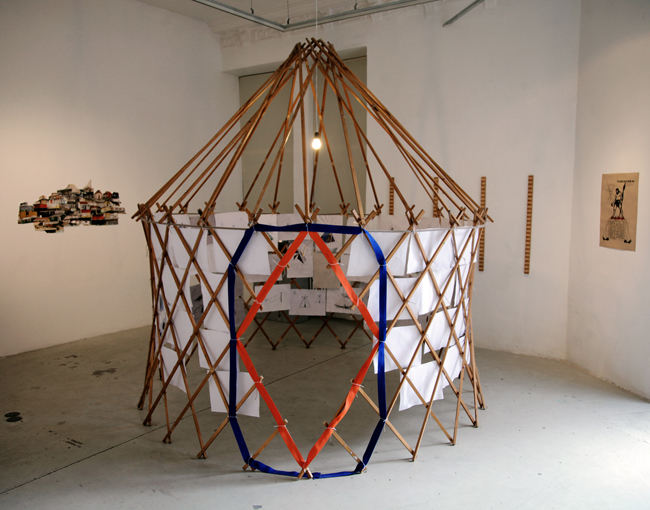Art as a Laboratory: Interview with Tamás Kaszás

Tamás Kaszás was born in 1976 in Dunaújváros, Hungary. He is a graduate of the Intermedia Department of the Hungarian Academy of Fine Arts, Budapest. Inspired by theoretical research, Kaszás’ projects are based on social questions and spiritual science. He mixes poetic images with practical “inventions,” creating large installations the artist calls “visual aid constructions.” Kaszás aspires to an economic and ecological art practice, designing easy-to-make structures from inexpensive and recycled materials using techniques readily available to anyone. The artist has exhibited his work at the 12th Istanbul Biennial, Istanbul (2011); Open Space, Vienna; SMAK, Gent; Ludwig Museum, Budapest; Storm Project, Utrecht; and Open Space, Vienna. Kaszás lives and works on the Szentendrei Islands, Hungary. His work can be viewed at http://kisterem.hu.
Janeil Engelstad: For many years you have explored political and social themes through your work. At some point, there was a shift in focus, where you began to concentrate exclusively on themes and ideas around sustainability, permaculture and natural living. Were these themes always running parallel in your life? Or was it a response connected to climate change, living in the urban environment of Budapest, or something else?
 Tamás Kaszás: It was a progression. From an early age, I was involved in politics. In secondary school I was quite interested in the anarchistic movement in Hungary. At the same time, I became interested in art, and then I became involved in punk culture. When I came to the Academy of Fine Arts in Budapest I focused on political topics along with conceptual questions connected to art. I made a work called Propaganda Barricade, which was a cart that could be pushed through the streets during demonstrations. It was also a platform for speaking, and if there was a fight it worked as a barricade. I also became quite active in the Budapest squat movement. For two years, a group of us squatters occupied a building in demonstrations against government corruption in Budapest and issues such as the large population of homeless people. I was also active in the Green Movement and in urban gardening. All of these activities began to direct my practice towards sustainability.
Tamás Kaszás: It was a progression. From an early age, I was involved in politics. In secondary school I was quite interested in the anarchistic movement in Hungary. At the same time, I became interested in art, and then I became involved in punk culture. When I came to the Academy of Fine Arts in Budapest I focused on political topics along with conceptual questions connected to art. I made a work called Propaganda Barricade, which was a cart that could be pushed through the streets during demonstrations. It was also a platform for speaking, and if there was a fight it worked as a barricade. I also became quite active in the Budapest squat movement. For two years, a group of us squatters occupied a building in demonstrations against government corruption in Budapest and issues such as the large population of homeless people. I was also active in the Green Movement and in urban gardening. All of these activities began to direct my practice towards sustainability.
JE: Throughout all of this, you were engaging the community in different ways and responding to different social issues. Did you consider the process of engagement to be a part of your creative practice?
TK: Actually, it was important for me to separate these two things. I always knew that, okay, now I am doing a political action, or now I am working on something artistic, even if it happened in a public space. But at the same time, I was thinking about how I might use my artistic creativity to solve social problems. A lot of the knowledge and ideas from my activist work I use in my creative practice today.
JE: So they were separate practices, but they were feeding each other.
TK: Yes, and after a time, I had the growing desire to leave the city and move to the countryside. I wanted a deeper quality of life that I could not get from activities such as keeping a garden in the city. I began to learn about agriculture and for three years, I was part of a collective garden in the countryside. Then I moved with my partner, Anikó Loránt, to an island on the Danube River. We are renting a small house and garden. We are using our commercial artistic practices to collect money for the next stage of our lives, which we call “the ex-artists stage” and this is why we call our collective activity The Ex-Artists Collective. So the main desire, or goal, now is to buy a house and to become an ex-artist.
JE: And then you will stop making art and completely move to agriculture?
 TK: I don’t think that I would totally abandon making art. With the financial crisis in Hungary, first the money disappeared and then the culture started to disappear, so what can an artist do now? This is, in many ways, a hypothetical question, because very few people can live from making art in Hungary. But somehow I was quite lucky because I was, more or less, making it in the art world and selling my work, such as paintings.I have had to earn my living by doing other jobs from time to time, but not that much. I haven’t had a regular job for many years. It helped that I kept my standard of living quite low and often lived from receiving residencies and scholarships. Now, however, given the state of the economy, that time is over and this is how the topic of surviving off the land came into my art. I was already learning practical things from folk science, including foraging for food and making a fire using only a piece of glass and the sun, that I am now using in my daily life; so it was a natural progression. In 2010, Anikó and I began, under the auspices of The Ex-Artists Collective project, The Famine Food Project where we started to collect plants from nature that we could eat, such as nettles. We knew about many of these plants from our childhood, but when we turned this knowledge into a practice for living, we began to learn new things and realized that we were developing a new way of living. We are exhibiting the data and materials from this project inside of spaces that we create out of wood, much like a yurt, within the museum or gallery. If the art system stays similar to what it is today so that I have to be represented by a gallery and do exhibitions to sell work, then I would like to collect enough money to buy a bigger garden or farm; then I could spend more time in the garden and less time making art.
TK: I don’t think that I would totally abandon making art. With the financial crisis in Hungary, first the money disappeared and then the culture started to disappear, so what can an artist do now? This is, in many ways, a hypothetical question, because very few people can live from making art in Hungary. But somehow I was quite lucky because I was, more or less, making it in the art world and selling my work, such as paintings.I have had to earn my living by doing other jobs from time to time, but not that much. I haven’t had a regular job for many years. It helped that I kept my standard of living quite low and often lived from receiving residencies and scholarships. Now, however, given the state of the economy, that time is over and this is how the topic of surviving off the land came into my art. I was already learning practical things from folk science, including foraging for food and making a fire using only a piece of glass and the sun, that I am now using in my daily life; so it was a natural progression. In 2010, Anikó and I began, under the auspices of The Ex-Artists Collective project, The Famine Food Project where we started to collect plants from nature that we could eat, such as nettles. We knew about many of these plants from our childhood, but when we turned this knowledge into a practice for living, we began to learn new things and realized that we were developing a new way of living. We are exhibiting the data and materials from this project inside of spaces that we create out of wood, much like a yurt, within the museum or gallery. If the art system stays similar to what it is today so that I have to be represented by a gallery and do exhibitions to sell work, then I would like to collect enough money to buy a bigger garden or farm; then I could spend more time in the garden and less time making art.
 JE: Do the skills and knowledge that you have acquired as an artist help you to solve problems in agriculture?
JE: Do the skills and knowledge that you have acquired as an artist help you to solve problems in agriculture?
TK: My aim with permaculture is to have an artistic activity where there is no separation between making and doing, between artist and audience. There is no mediator such as a gallery. Permaculture it is not just about farming, it is a way of thinking. It is like using a pipe to connect all of these different elements that are a part of our living space and those skills I acquired as an artist. To figure out such things, to build things on a farm, to design a garden, I use the same process that I use to build an exhibition. As an artist, you can deal with problems even if you don’t know the solutions. You can just raise questions. The openness of art (as a field that allows for play and experimentation) lets people come up with their own models for using art as a tool for living.
JE: What is the role of aesthetics in your work? Is this something that you consider?
TK: It is important that the work be presented in such a way that people can access it. For many people, it is not easy to engage with a work of art if there is a lot of text to read or videos to watch. Aesthetics are important in helping people access the work in a way that is visually engaging and interesting.
JE: Do you hope that your exhibitions, even if sited in traditional art spaces, will result in some sort of positive change or action in the greater community?
 TK: Yes, I hope that my work can inspire people to live a more sustainable life. We are working for a simple and happy life, but, unfortunately, I don’t think that I can come up with a system to stop capitalism.
TK: Yes, I hope that my work can inspire people to live a more sustainable life. We are working for a simple and happy life, but, unfortunately, I don’t think that I can come up with a system to stop capitalism.
JE: It would be an interesting experiment…
TK: Yes, I see institutional art as a laboratory for research and as a place to try ideas connected to permaculture and folk science. Folk science is really connected to this idea of deep knowledge that informs our existence. Many of these traditions, such as using herbs to treat illness, are still alive in the developing world. If there is a bigger global crisis, the developing world can more easily survive because they live closer to the ground. They won’t have so far to fall.

May 2013, Budapest, Hungary




